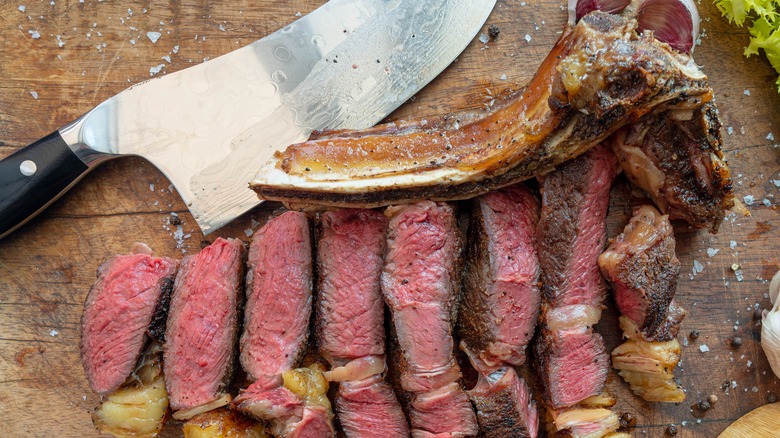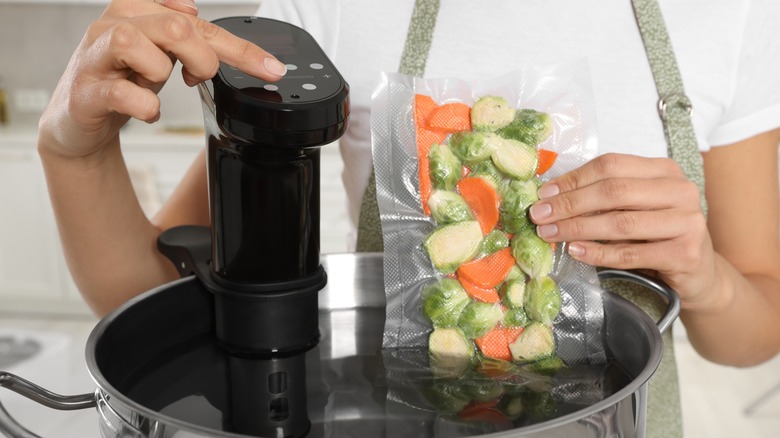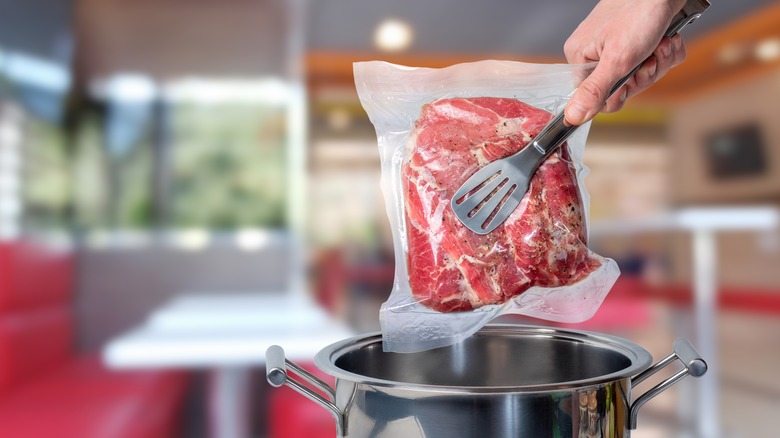Sous Vide Is The Simple Cooking Method For Elevating A Cheap Cut Of Meat
While low and slow might describe the concept employed by the pitmaster, sous vide is another controlled cooking method that can transform a tougher meat cut into a terrific bite. Submerged in a water bath, the vacuum-sealed meat gently and slowly reaches a desired internal temperature, which remains during cooking. Over several hours, the fat inside the meat slowly melts and adds a robust flavor. Chef Chris Holland explains that the slow, controlled sous vide cooking allows the collagen to break down, and the tough, sinewy pieces transform into tender, delicious bites. For anyone who is looking to save a few dollars, sous vide can turn that cheap cut of meat into a buttery, tender bite.
The butcher case can be full of familiar cuts like the filet, tenderloin, and T-bone. While those celebrated varieties can be more tender, they come with a higher price tag. As many chefs appreciate, other underutilized meat cuts, like a hanger steak, can be flavorful when cooked correctly. Instead of avoiding that flank cut, being strategic with cooking, seasoning, and serving methods can make that tougher cut palatable. Sous vide is a way to give cost-conscious cuts an elevated flavor.
Although the wagyu steak or tomahawk chop might tempt the deep pocket spenders, flavorful cuts of meat can be found on any budget. With patience and control from sous vide cooking, that less pricey cut of meat can taste like a million bucks.
The real reason why home cooks should learn to sous vide
While some people have mastered the grill and others might have finally poached the perfect egg, learning to sous vide could be the next cooking technique to tackle. MasterClass explains various reasons for employing this concept, most of which have to do with simplicity. From minimal clean-up to cooking multiple recipes at once, the process can streamline a home cook's time in the kitchen.
Although the cooking device might be an investment and it appears technical, the process gives a cook one big advantage: The food is rarely overcooked. Unlike the low and slow smoker that can impart an acrid taste or the slow cooker that can have temperature fluctuations, sous vide is all about the exact, maintained temperature. From the short ribs that cook for almost a day or the salmon that cooks quickly, no one has to stand over the heat source with a careful eye. The water bath temperature is constant, eliminating that oops moment.
Even if food television shows highlighted this concept as a scientific gadget, the reality is that anyone can master the technique. For cooks tired of under-seasoned and overcooked food, it could be time to break out that plastic bag, a big pot of water, and the immersion circulator.
Simple sous vide tips that any home cook can master
While the French term might imply complex cooking techniques, a few simple sous vide tips can turn anyone into a slow-cooking master. Although not quite as simple as the slow cooker dump and simmer option, the vacuum-sealed, low, slow, controlled method is easier than it seems.
According to Great British Chefs, adding a little oil to the vacuum-sealed bag can help the protein keep its overall shape. A flavor-infused oil or marinade is meant to help retain the cell structure during the long cooking process. When cooking more delicate items, like fish, consider leaving the skin on during cooking. It can be removed or crisped quickly in a skillet for added texture.
Also, sous vide can be a great way to infuse flavor into a dish. From a simple pickled vegetable to herbal fruit, the tightly sealed bag intensifies absorption. Even if the process is less than an hour, the final result will taste like it took all day.
From making cheaper cuts of meat tender to making quick work of that sticky toffee, there are plenty of reasons to discover the usefulness of sous vide cooking. It might look like a science experiment, but it explores creative flavor.


